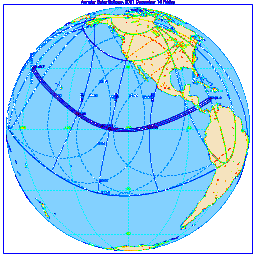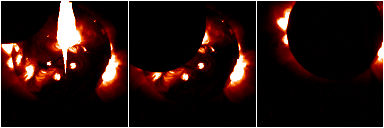
This science nugget marks a new epoch for Yohkoh, unfortunately. The spacecraft has had a SOHO-like problem and is presently not returning scientific data. Unfortunately the onset of this condition coincided with the annular eclipse we report here. The spacecraft will not be recoverable soon, so this will be the last of the nuggets dealing with really current data. In the interim, of course, there are many items that we will eagerly wish to present to you, so we'll continue our weekly schedule without reference any longer to the current observations.
First, check out the predictions of the eclipse, featuring movies made from pre-eclipse images. As one can see from these calculations (from M. Soma of NAOJ), the eclipse was almost a perfect one. From the Earth the view was only annular, meaning not so good for coronal viewing. From space, however, it's just about as good.
The eclipse track traversed the Pacific, probably causing severe daytime darkness in some (but not many) islands, including Hawaii:

This sort of plot shows the shadow position as a function of time. The Yohkoh moment was predicted as 20:58:03, and turned out to be about 15 seconds later. This is not unexpected because the satellite moves so fast that small errors in its ephemeris (based on orbital parameters determined several days ahead of the event) can easily be amplified that much. At this time the Yohkoh orbit intersected the eclipse path in the desolate Pacific just about midway between Hawaii and the Galapagos. The data then made their way swiftly through NASA's Wallops Island tracking station and to ISAS.
What happened (?)
Things developed exactly according to plan until nearly the moment of totality (or annularity, maybe):

Click on the image above to get a clearer view, which shows several things. First, the active region just north of disk center was flaring, resulting in a huge saturation bleed in these long exposures (yes, it had an interesting sigmoid character that we may deal with in a future nugget). Second, the final image shows how the Moon neatly matches the solar disk, leaving an X-ray totality. But, the tragic news is already visible here - the Yohkoh attitude control system could not handle this strange input, which must have appeared as an unscheduled sunset. This was a factor in throwing the spacecraft into a "safehold" state, in which it remains. Recovery from this will be difficult, so this image at 10:58:01 UT, December 14, 2001, will be the last current image from SXT this year. It is at least esthetically nice but we sure wish we had more data!
Conclusion
There is no real conclusion here. We have often observed solar eclipses with SXT in the past (see our topical index for example). For the most part these data have little scientific value, although they nicely illustrate many things about how space observatories work. The only practical use we've made thus far has to do with characterizing mirror scattering (you can see some on the extreme east limb of our images), an important concern for measuring the brightesses of faint features in the corona - see the blur where the arrow below points.

We also have two excellent examples of "knife-edge" imaging, from which we can learn something unique about the finest structural scales in the X-ray corona. Because this analysis is difficult, however, nobody has yet volunteered to do it.